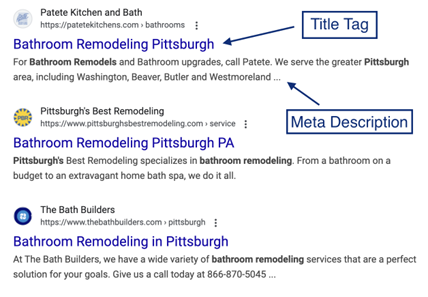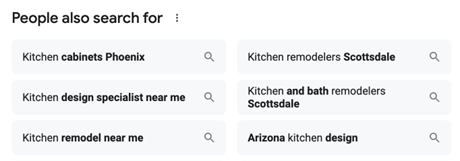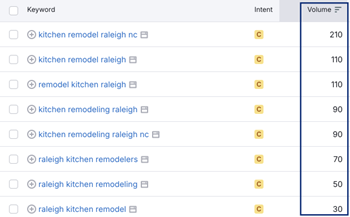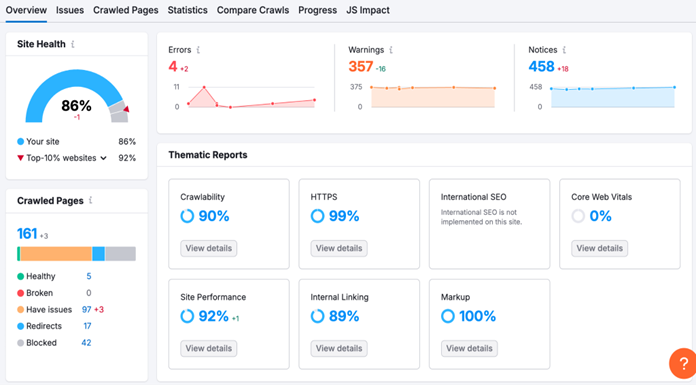Develop Local SEO
When it comes to digital marketing for remodelers, local SEO is where the magic happens.
It makes sure your business gets noticed by people who are actively looking for remodeling services right in your area.
In my experience, when done right, local SEO skyrockets your visibility.

People want to find local businesses that meet their specific needs.
That’s where you come in.
Local SEO is all about getting your name out there in local search results.
It means tweaking your Google Business Profile (GBP), racking up reviews, and keeping your contact info consistent everywhere online.
So why does it matter?
- Increases Visibility: Let’s face it — most folks aren’t going past page one of Google. If you’re not showing up there, you’re losing out on big opportunities.
- Boosts Traffic: Local SEO puts you in front of people who are already searching for remodeling services. Talk about targeted traffic.
- Builds Trust: A solid GBP boosts your credibility. People trust businesses they find in local searches — it’s that simple.
Let’s break it down, step by step:
Claim Your Google Business Profile (GBP)
Your Google Business Profile (GBP) is a free tool that allows you to manage how your business appears on Google Search and Maps.

It’s a vital asset for your business.
Why?
This tool boosts your local presence and puts your business right in front of people who are actively looking for your services.
Optimizing your GBP is a key step in improving your SEO for remodelers.
Here’s how:
1. Visit the Google Business Profile Page
Go to google.com/business. This is where you’ll start the claiming process.

2. Sign In or Create an Account
If you already have a Google account, sign in. If not, you’ll need to create a new account to proceed.
3. Enter Your Business Name
Type your business name into the search bar. If it appears in the dropdown, select it. If not, click on “Create a business with this name.”

4. Choose Your Business Type & Category
Choose your business type:

Then, select the category that best fits your services.
For remodelers, options might include “Remodeler,” or specific remodeling categories like “kitchen remodeler” or bathroom remodeler.”

5. Enter Your Business Information
Fill in your business details, including the address, phone number, and website. Even though it says “optional,” you need to complete this step.
Make sure this information is accurate and matches what’s on your website and other listings.

6. Verify Your Business
Google will ask you to verify your business. This is usually done through a postcard sent to your business address, but you may also have options for phone or email verification.
Follow the instructions provided to complete this step.
Optimize Your GBP
The next crucial step is to optimize your GBP.
An optimized GBP not only improves your visibility in local search results but also helps potential clients understand your services better.
The more info you can include, the better
Here are some key strategies:
1. Complete Your Profile
Ensure every section of your profile is filled out completely.
This includes your business name, address, phone number, website, and business hours. A complete profile increases your chances of appearing in local search results.

2. Use High-Quality Images
Add high-quality images that showcase your work.
Include before-and-after photos of remodeling projects, images of your team, and any awards or recognitions. Visual content is powerful in attracting potential clients.

3. Write a Compelling Business Description
Craft a clear and engaging business description.
Use this space to highlight what makes your remodeling services unique. Mention specific services you offer, your experience, and your commitment to quality.

4. Post Updates and Offers
Regularly post updates, offers, or photos of recent projects.
Google allows you to create posts similar to social media updates. This not only keeps your profile fresh but also engages potential clients by showcasing your latest work and promotions.

5. Utilize Attributes
Add relevant attributes to your profile.
For instance, if you offer free consultations or have special certifications, make sure to highlight these. Attributes help set you apart from competitors.
6. Monitor Insights
Use the insights feature in GBP to track how customers interact with your profile.

Analyze data such as how many people view your profile, click on your website, or request directions. This information can guide further optimizations.
Ask for Reviews
Want to boost your Google Business Profile (GBP) and supercharge your local SEO?
Ask for reviews.
Good reviews do more than just build trust — they directly impact your ranking in local searches and get you noticed by potential clients.

Here’s how to make it work:
- Timing is Everything: Ask for reviews right after you’ve wowed your clients — when they’re at their happiest
- Make It Effortless: Send clear instructions with a direct link to your GBP so they can leave a review in seconds
- Personalize Your Ask: Reference specific details from their project. It’ll make them feel valued and more likely to write a great review.
- Explain the Impact: Let clients know how their feedback helps others find your top-notch services and supports your business growth
- Engage with Every Review: Respond to positive reviews and address any negative ones with care
- Showcase Your Reviews: Share glowing testimonials across your website, social media, and marketing materials to reinforce your credibility
Perform Keyword Research
There’s a joke in my industry:
Where’s the best place to hide a dead body?
On the second page of Google.
While it may be dark humor, it’s dead-on accurate.
In fact, just 0.44% of people click to the second page of Google.
That’s not a typo — less than one percent of users are getting to page two…unless they have a body to bury.
So, what does that mean for you?
It’s simple:
You need to be on page one.
And it all starts with keyword research.

A fundamental element of any successful SEO for remodelers strategy, keyword research involves identifying the terms and phrases potential clients use when searching for remodeling services.
But here’s the deal:
We want to be specific.
So, we wouldn’t focus on super broad terms like “remodeling.”
Why?
Because most of the people searching that term aren’t even in your service area.
So, we’d want to hone in on more specific phrases that your local potential clients might use. Such as “kitchen remodel in [location]” or “bathroom renovation services near me.”

This specificity can help drive you right to the top of Google.
And once you’re there, you’ll attract not just more traffic, but the right traffic — people in your area actively looking for remodeling services and ready to convert.
Find Keyword Ideas
Finding the right keywords is essential for targeting your audience effectively.
Here are three effective methods to discover keywords that will help elevate your SEO strategy:

Analyze Competitor Websites
Look at the websites of your competitors, particularly those who rank well in your area.
Examine their content, meta tags, and the keywords they target.

Experiment with tools like Moz or SpyFu which can help you uncover the keywords your competitors are using successfully.
This analysis can reveal gaps in your own keyword strategy and identify opportunities to stand out.
Utilize Google Search Suggestions
Google’s own search suggestions can be a goldmine for keyword ideas.
Start typing a relevant term into Google, and pay attention to the autocomplete suggestions that appear.
Like this:

These suggestions are based on actual search queries and can help you identify popular topics and phrases that potential clients are actively searching for.
Additionally, check the “People also ask” and “People also search for” sections in search results to find related questions that can inspire more specific keywords.


Analyze Keyword Data
Okay, now you have your list of keywords.
For some of you, there might be dozens. For others, it could be hundreds.
You may be asking yourself “What the hell am I supposed to do with all these terms?”
Analyze them.
Keyword analysis helps you figure out which keywords are worth targeting. Based on their search volume, competition, and relevance to your business.
Here are some key factors to consider:
Search Volume
Look for keywords that have a significant search volume.

This indicates that many people are searching for these terms, which can lead to increased traffic if you rank well.
Aim for a mix of high-volume keywords and niche phrases that reflect your specific services.
Keyword Difficulty
Assess the competition for each keyword.
Tools like Semrush and Ahrefs provide a keyword difficulty score, indicating how challenging it may be to rank for a particular term.

Focus on a combination of competitive and less competitive keywords to balance your strategy.
Relevance to Your Services
Ensure that the keywords you choose are closely related to the services you offer.
This is where your understanding of SEO for remodelers comes into play.
For example, if you specialize in bathroom renovations, prioritize keywords that include terms like “bathroom remodeling” or “bathroom design ideas.”
By diving deep into keyword data, you can craft a strategy that increases your chances of ranking higher and attracting the right visitors to your site.
Prioritize and Target Keywords
After analyzing the keyword data, it’s time to prioritize which keywords to target in your content.
Here are some guidelines to help you choose the best keywords for your remodeling business:
Focus on Search Intent
You need to understand why people are searching.
Are they gathering information, looking for services, or ready to make a purchase?
A quick glance at Google reveals the type of content it serves based on intent.
For instance, a person searching “how to remodel a kitchen” is likely just kicking the tires, gathering info.
And the content Google serves that user will be educational, like “How-to” guides, blogs, etc.:

But a person searching “kitchen remodeling services near me” is primed to book a consultation.
And the content Google serves that user will be transactional, like service pages, GBP profiles, etc.:

Balance Competition and Search Volume
Aim for a mix of high-volume and low-competition keywords.
While high-volume keywords can bring more traffic, they often come with stiff competition.
Low-competition keywords may have less search volume but can lead to higher conversion rates because they attract more targeted traffic.
Create a Keyword List
Organize your prioritized keywords into a list.
This list will serve as a guide for your content creation efforts. Use categories to separate keywords based on topics, services, or target audiences, making it easier to develop relevant content.
Monitor and Adjust
Your SEO for remodelers strategy isn’t a set-it-and-forget-it deal.
Track your keyword performance, and stay flexible.

Adjust as search volume and competition shift, and be ready to incorporate new trends.
By focusing on the right keywords and continuously tweaking your strategy, you’ll boost your visibility and attract more clients actively searching for your remodeling services.
Keyword Research Tools: A Comparison
Wondering what the right keyword research tool is for your SEO for remodelers strategy?
Here’s a breakdown of some of the most popular options, highlighting their features, pricing, and best use cases to help you choose the best fit for your remodeling business.
Conduct Competitor Analysis
You may think you know who your competitors are.
But do you really?
In my experience, I’ve worked with many clients who would name competitors down the street.
What they didn’t realize is that their real competition wasn’t just around the corner — it was online.
And they didn’t even know about it.
That means truly understanding your competition is crucial for refining your SEO for remodelers. And ensuring that your remodeling business stands out.
Conducting a thorough competitor analysis can reveal valuable insights into what works and what doesn’t in your market.
Find Your Competitors
Identifying your competitors is a crucial step in the competitor analysis process.
Knowing who you’re up against allows you to tailor your SEO strategy effectively. Here are some methods to help you find your competitors:
Local Search Results
Start by performing local searches for remodeling services in your area.
Use keywords relevant to your business, such as “kitchen remodeling in [location]” or “bathroom renovation services near me.”
The businesses that appear in the top results are your primary competitors.


Google Maps
Utilize Google Maps to find local remodelers. Enter your service categories and check the listings that pop up.
This can give you a visual representation of who is operating in your vicinity and how they rank.
Industry Directories
Explore industry-specific directories and local business listings. Think Yelp, Angie’s List, or HomeAdvisor.
These platforms often highlight top-rated contractors and can provide insights into the competitive landscape.


Social Media
Check social media platforms for local remodeling businesses.
Search for hashtags relevant to your industry, such as #remodeling, #homerenovation, or #[location]Remodeling.
Pay attention to businesses with a strong following and engagement, as these can be significant competitors.
Competitive Analysis Tools
Tools like Semrush, Ahrefs, or SpyFu can help you identify your competitors by providing insights into which websites are ranking for the keywords you’re interested in.
By entering data into these tools, you can generate a list of sites that compete for the same audience, allowing you to focus on those that are most relevant to your business.
Analyze Content
Review online articles, blogs, and resources related to remodeling.
Many publications feature local contractors or highlight industry leaders. This can provide additional insight into who is recognized in your field.
Analyze Their Strategies
Once you’ve identified your competitors, the next step is to analyze their strategies.
Understanding what works for them can provide valuable insights for refining your own SEO for home remodeling.
As you evaluate your competitors, ask yourself:
Keyword Usage
- Are they sticking to short-tail or mixing in some long-tail keywords?
- Which local keywords are they using?
Tools like Semrush or Ahrefs can help you see which keywords are driving traffic to their sites.
Content Quality and Types
- What’s the quality of the content they’re producing?
- Are they keeping their blog updated with fresh posts?
- Do they use video, infographics, or case studies?
- How is their content engaging their audience?
Content isn’t just filler — it’s fuel for SEO.
The better the content, the stronger the SEO.
Backlink Profiles
- What does their backlink profile (more on this later) look like?
- How many backlinks do they have, and what is the quality of those links?
- Who is linking to them?
Analyzing their backlinks can help you identify potential opportunities for your own site.
Adapt Your Approach
Now that you’ve conducted a thorough competitor analysis, it’s time to adapt your approach based on the insights you’ve gathered.
Leverage Competitor Keywords
Utilize the keywords that your competitors are successfully targeting.
Incorporate these keywords into your own content while also identifying gaps they may have missed.
This can help you capture search traffic that is currently going to them.
Create Unique, High-Quality Content
Differentiate yourself.
How?
By producing high-quality, unique content that addresses the needs and interests of your target audience.

If competitors are focusing on specific topics, find angles they haven’t explored or expand on them with your insights and expertise.
Enhance On-Page SEO
Review your competitors’ on-page SEO strategies.
Are they optimizing title tags, meta descriptions, and headers effectively?
Ensure that your website uses these elements to improve search engine rankings. And use relevant keywords naturally in these areas to enhance visibility.
Optimize Website Structure
Assess your competitors’ website structure and user experience.
Ensure that your site is easy to navigate, with a logical hierarchy and clear paths for users to find information.

A well-structured site improves crawlability for search engines, which can enhance your rankings.
Monitor and Adjust Your Strategy
Regularly track your keyword rankings and organic traffic.
Use tools like Google Analytics and Google Search Console to monitor performance.

If you notice competitors ranking for new keywords or topics, be ready to adjust your strategy and content accordingly.
Create Quality Content
Content writing is where I made my bones in this industry.
Before all the AI tools, before all the “content mills,” I was sitting down, cracking my knuckles, and putting words to paper (or screen, if we’re being real).
Even in today’s world of AI-generated everything, I still take pride in it.
Real, high-quality content.
That’s the stuff that makes a difference.
You can’t just throw a bunch of words together and call it a day.
You have to speak to your audience. You have to hit their pain points. You have to provide value.
When it comes to SEO for remodelers, creating content that resonates with your audience is everything.
It’s how you pull in those leads and convert them into paying clients.
And yeah, using the right keywords?
That’s part of it.
But it’s more than that.
It’s about producing content that’s real, relevant, and useful — content that doesn’t just sound good, but actually works to improve your SEO and attract the right people to your remodeling business.
Draft Kickass Service Pages
One of the most effective ways to enhance your website’s SEO is by creating detailed service pages.
Here’s how to draft compelling service pages that attract and convert potential clients:
Clear and Descriptive Headings
Start with clear and descriptive headings that include relevant keywords. These headings should clearly indicate the service being offered.
For example, instead of simply using “Bathroom Remodeling,” opt for something like “Expert Bathroom Remodeling Services in [location].”
This not only informs visitors about what to expect but also helps with SEO.
In-Depth Descriptions
Next, provide in-depth descriptions of each service you offer.
Explain the process, benefits, and what sets your services apart from the competition.
Make sure to use relevant keywords naturally throughout the text to enhance SEO without compromising readability.
Engaging Visuals
Engaging visuals are a game-changer.
Use high-quality images and videos that showcase your best work.
Not only do they make your page more visually appealing, but they also help potential clients see what you’re capable of.
Visual content builds trust and gives your brand a professional, credible feel.

Client Testimonials
Additionally, don’t forget to include client testimonials.

Incorporating testimonials or case studies related to the specific service adds credibility and showcases your successful projects, encouraging potential clients to reach out.
Strong Calls to Action (CTAs)
Finally, conclude your service pages with strong calls to action (CTAs) that prompt visitors to contact you for quotes or consultations.

Effective CTAs help guide potential clients toward taking the next step.
Build a Location Page Strategy
Location pages are your secret weapon for local SEO.
Each page should zero in on the services you provide in a specific area, so you can target the keywords your potential customers are actually searching for.
Target Specific Locations
Don’t just create generic service pages.
Tailor them to each location.
For example, if you specialize in kitchen remodeling, create a page titled “Kitchen Remodeling in [Location].”
Highlight not only your services but also showcase local projects, trends, and any unique regulations relevant to that area.

Emphasize Local Relevance
The more your content speaks to the local audience, the better it’ll perform.
Include details about past projects in the area, testimonials from local clients, and keywords that tie directly to that community.
This tells search engines — and your potential customers — that you’re not just another remodeling company.
You’re the remodeling company for their specific needs.

This approach not only enhances your visibility in local search results but also establishes trust and credibility.
Add FAQs
Incorporating a Frequently Asked Questions (FAQ) section on your service and location pages can significantly enhance user experience and improve your SEO for remodelers strategy.

FAQs address common inquiries and concerns that potential clients may have, helping to inform and engage them effectively.
Here’s how to create an impactful FAQ section:
Identify Common Questions
Start by researching the most common questions your potential clients ask about your services.
This can include inquiries about pricing, project timelines, materials used, and the remodeling process itself.
Utilize tools like Google’s “People also ask” feature to identify relevant queries that align with your offerings.

Provide Clear and Concise Answers
Once you’ve identified the key questions, write straightforward answers that are easy to understand.
Aim for brevity while ensuring you provide enough detail to address each question effectively.
Using bullet points or short paragraphs can enhance readability and help users quickly find the information they need.
Incorporate Relevant Keywords
Naturally include relevant keywords within your FAQ questions and answers.
This not only helps with SEO but also ensures that your content is aligned with the search queries potential clients may be using.
For example, a question like “How much does kitchen remodeling in [Location] cost?” targets both the service and the local aspect.
Regularly Update Your FAQs
Keep your FAQ section current by regularly reviewing and updating it to reflect any changes in your services or new common questions.
This commitment to providing up-to-date information enhances credibility and improves the overall user experience.
Build Backlinks
A backlink is when one website links to another.
So, why should you care if someone else is linking to your site?
Because it’s like a vote of confidence from that website to yours.
It signals to search engines that your content is reliable and credible, which is crucial for your SEO for remodelers strategy.
For remodelers, acquiring high-quality backlinks can enhance visibility and drive targeted traffic.
These tactics can help you cultivate a diverse and effective backlink profile:
Submit to Local Directories
Submitting your business to local directories is a vital step in enhancing your online visibility and improving your local SEO.
Local directories serve as platforms where potential clients can find services in their area, making it essential for remodelers to ensure their business is listed accurately.
Start by identifying reputable local directories relevant to your industry, such as Yelp, Angie’s List, HomeAdvisor, and local chambers of commerce.

Create a complete and consistent listing that includes your business name, address, phone number, and a brief description of your services.
Use relevant keywords to optimize your listing for search engines, making it easier for potential clients to find you.
Monitor Your Backlink Profile
Keeping tabs on your backlink profile is crucial for maintaining SEO health and authority.
A solid backlink profile can skyrocket your rankings.
But a weak or toxic one?
It can tank your visibility and even get you penalized by Google.
Here are key strategies to monitor your backlinks effectively:
Use Backlink Analysis Tools
Leverage tools like Ahrefs, Semrush, or Moz to regularly analyze your backlink profile.

These tools provide insights into the quantity and quality of backlinks, allowing you to identify valuable links and any potentially harmful ones.
Track New and Lost Backlinks
Keep an eye on new backlinks that are acquired, as well as any links that are lost.
Understanding these dynamics can help you assess the effectiveness of your outreach efforts and identify areas for improvement.
Evaluate Link Quality
Not all backlinks are created equal.
Focus on acquiring high-quality links from reputable sources within the remodeling industry or related fields. Regularly review your backlink profile to identify any low-quality or spammy links that could negatively impact your SEO.
When working on SEO for bathroom remodel companies, I’m always vigilant for toxic links that could damage a site’s authority and rankings.
Disavow Toxic Links
If you discover toxic backlinks that could harm your site’s reputation, consider using Google’s Disavow Tool.
This allows you to inform Google that you do not want these links to be considered in your site’s ranking.

Use this tool with caution: The Disavow Tool should only be used in certain situations and as a last resort.
Analyze Competitor Backlinks
Monitor your competitors’ backlink profiles to uncover new opportunities.
Tools like SpyFu or Semrush can help you see where your competitors are getting their backlinks, allowing you to strategize your outreach efforts.

Improve Technical SEO
A lot of clients ask me:
“Chris, what the f#ck is ‘Technical SEO’?”
If your website was a car, technical SEO is like under-the-hood maintenance.
Just like a well-tuned engine ensures top performance and fuel efficiency, technical SEO optimizes your website’s infrastructure to boost speed, reliability, and functionality.
If your car’s parts are neglected, it’ll break down.
Same goes for your site.
Slow load times, broken links, or improper indexing can slow you down, making it harder for search engines to crawl and rank your pages.
By checking and tweaking your site’s technical aspects regularly, you keep it running like a well-oiled machine — and improve your SEO for remodelers strategy along the way.
Conduct a Site Audit
Conducting a comprehensive site audit is a vital step in improving your technical SEO.
A site audit helps you identify issues that may be hindering your website’s performance, search engine visibility, and user experience.
- Use SEO Audit Tools: Leverage tools like Screaming Frog, Semrush, or Ahrefs to conduct a detailed analysis of your website. They provide insights into various technical aspects, including broken links, duplicate content, and missing metadata. When working on SEO for kitchen remodeling, these tools are invaluable for pinpointing areas of improvement.
- Check for Broken Links: Identify any broken links on your site, both internal and external. Broken links can negatively impact user experience and hurt your SEO. Ensure that all links point to active pages and update or remove any that are not functioning.
- Optimize for Mobile Usability: Ensure your site is mobile-friendly. A significant portion of web traffic comes from mobile devices, so it’s crucial that your site provides a seamless experience across all devices.
Review Site Structure
A well-organized site structure is essential for both user experience and search engine optimization.
A clear hierarchy helps users navigate your site easily while allowing search engines to crawl and index your pages more effectively.
- Create a Logical Hierarchy: Organize your site into categories and subcategories that reflect your services and content. This structure makes it easier for visitors to find what they’re looking for and helps search engines understand the relationships between your pages.

- Use Descriptive URLs: Ensure that your URLs are descriptive and include relevant keywords. A clean URL structure aids in better indexing by search engines and provides users with a clear idea of the content on the page.
- Implement Breadcrumbs: Use breadcrumb navigation to help users understand their current location within your site. Breadcrumbs also provide additional context to search engines about the structure of your content.
Enhance Page Load Speed
Page load speed is a critical factor that impacts user experience and SEO. Slow-loading pages can frustrate users, leading to higher bounce rates and lower search engine rankings.
- Optimize Images: Compress images without sacrificing quality to reduce load times. Use formats like WebP or JPEG for optimal balance between quality and file size.
- Minimize HTTP Requests: Reduce the number of elements on each page (like scripts, images, and stylesheets) to lower the number of HTTP requests made when a user accesses your site.
- Leverage Browser Caching: Enable browser caching to store certain elements of your site locally on users’ devices. This allows returning visitors to load pages faster, improving overall user experience.
Technical SEO Tools: A Comparison
The right technical SEO tools are essential for optimizing your website’s performance.
Let’s compare some of the top tools available, helping you choose the best fit for keeping your site running smoothly.
Click the table below to view larger:









